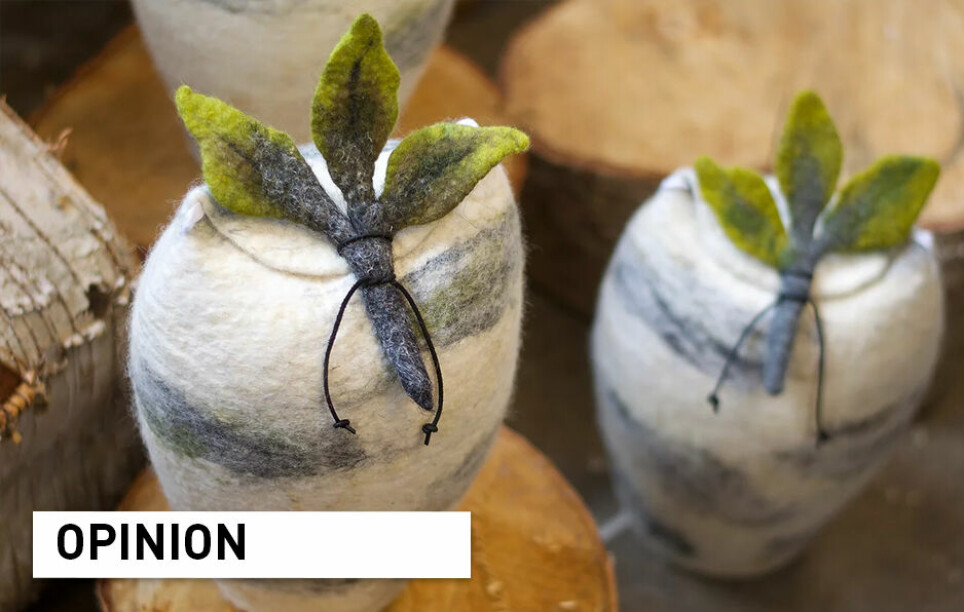Opinion:

From burial urns to surfboards – wool can be used to make just about anything
OPINION: There’s no such thing as bad wool, only bad use.
In the Norwegian folk song Kråkevisa (The Crow Song), a man made everything from a boat, to windows, to barrels of meat and fat from a bird he shot. There is a lot to learn from this – did you know that anything from burial urns, flowerpots, surfboards to sanitary towels and diapers can be made from wool?
Share your science or have an opinion in the Researchers' zone
The ScienceNorway Researchers' zone consists of opinions, blogs and popular science pieces written by researchers and scientists from or based in Norway. Want to contribute? Send us an email!
Wool can replace plastic
Poland is one of many EU countries where little or none of the wool produced is actually used. The Polish-Norwegian research project WOOLUME is working towards better utilisation of this resource, wool from Polish Mountain sheep. A new report from the project shows that anything from gardening products to insulation to personal hygiene products, as well as burial urns, coffins and surfboards are now being made of wool and has the potential to be made from the wool that is currently being thrown away in Poland and other EU countries, and that we call vacant wool. The products utilise the natural properties of wool, such as biodegradability, moisture absorbance, temperature regulation and nutritional content.
As much as 80 percent of the wool in the EU is probably being thrown away (...)
Several of these products, such as sanitary towels and diapers, are predominantly made of plastic. Microplastic pollution from the production, use and disposal of synthetic materials is a major environmental problem. According to the new national strategy on plastics, Norway alone emits an estimated 1017 tonnes of micro-plastics annually. Reducing the use of plastic we have little control over, such as in clothing and single-use products like sanitary towels and diapers, is therefore urgent. Wool is biodegradable and if not contaminated with toxic chemicals, wool products can be used as a fertilizer, for soil improvement or be composted after use.
There is no bad wool, only bad resource utilisation
Several of the products described in the report are made from wool that is suitable for clothing production. This is completely unnecessary because the properties that are important for these products also exist in wool that is unsuitable for clothing production. In order to reach the goals of the circular economy of keeping materials in use and achieving a high degree of resource utilisation, the choice of raw materials is important. Unfortunately, when it comes to wool, the market defines quality as “soft, easily spinnable and mass-producible”, and not according to the usability for the product in question.
Merino wool is therefore favoured on the global market. This is a raw material that, similarly to plastic, is easily available because it can be used for most applications. However, by using spinnable wool when this property is not important, other wool qualities remain unused as we have discussed in a previous report from the project where the use of wool in sound-absorbing products is examined (WOOLUME report 1). There is no such thing as bad wool, but there is plenty of bad utilisation of this and other resources.
The current debate on the environmental impact of animal products is important. New knowledge on methane and CO2-sequestering has created a more nuanced picture of the impact from sheep and cattle and the goal to reduce the number of these animals must be re-evaluated (Sauer og kyr i lys av alternative klimatall). But even with this new knowledge, Earth’s production capacity remains limited, and if we are to replace fossil materials – which should be evident – we must take better care of other raw materials.
Global wastage
As a by-product of industrialisation, increased profit through standardisation and rationalisation has replaced good resource utilisation. Valuable, already available materials are lost every day. This is a result of the global mass-producing industry and the growth paradigm that has made Europe so affluent, but with catastrophic consequences for nature, climate, animals, and people. The textile industry has historically been a driver for these changes.
In our brand-new book Local, Slow and Sustainable Fashion: Wool as a fabric for change we discuss the importance of local clothing for sustainability in a wider context. The textile industry is one of the most globalised, with extremely low prices, overproduction, uneven (to put it mildly) distribution of money and power, little transparency, and minimal control. This also influences the use of local materials.
As much as 80 percent of the wool in the EU is probably being thrown away but is not defined as waste but as a by-product of the meat and dairy industry. This influences the wool quality: wool needs professional shearing and immediate sorting so that impurities are removed, and quality is maintained. Good shearing and sorting are expensive. Furthermore, a collection system is needed to make the wool available for production. Luckily, in Norway, we have this, but we could tell the same sad story about hides from hunting and endless other examples of waste of Norwegian natural resources (Naturgarvet skinn i et miljøperspektiv).
So far, the EU and Norway have forgotten about small scale and local production in the climate debate, at least when it comes to clothing and textiles.
In Norway too, we need to find better utilisation for the most difficult wool and waste from consumption and production. The NIBIO/NORSØK-project VerdifULL has been working to increase the value of the down-graded wool by testing the use of wool mats for soil covering. The EU-project Ascent has, in collaboration with Hordaland county, tested a method from the Roman Empire where wool was used as a material to make footpaths. ULU is a good example of how a by-product and side-streams from other activities can be redirected to become resources for developing high-quality products. We also need to rebuild shoddy factories so that the worn-out wool from Norwegian consumers can be used again.
Lack of policy for local textile production
Good resource utilisation should be a given in the circular economy, but the EU is focusing on waste, not underutilised resources, and in Norway – well, we’re waiting in anticipation! So far, the EU and Norway have forgotten about small scale and local production in the climate debate, at least when it comes to clothing and textiles. When we, in Norway, are frontrunners in terms of taking care of our wool, it’s because of a value chain with small and large spinning, weaving and knitting mills and a large local market. Our knowledge is therefore very relevant for the development in the EU.
The man who shot the crow had both imagination and skill. From that we can learn that to use «everything», also side-streams and by-products, if that’s what we must call it, we have to notice and understand these resources. Collaboration and local production possibilities are also necessary. Otherwise, the easiest raw materials to exploit will be the ones already available on the global market.
The understanding of the importance of local production is very limited within the field of clothing and textiles. Here everything from policy to labeling to words and concepts is missing. This became extremely evident when our health and well-being depended on whether China would (and could) export face coverings and protective clothing. The Norwegian politicians should, in other words, hum Kråkevisa a bit more often. Maybe our Minister of Finance, Trygve Slagsvold Vedum, could lead the choir and ensure that policy for local clothes and textiles is developed, whether you call it self-sufficiency in case of emergency, resource utilisation, job creation or value creation? There is a lot to recover from what has been sacrificed on the altar of offshoring.
The "Kråkevisa" song ends by saying that the one who cannot use a crow in this way, does not deserve a crow. In the climate and environmental debate, this is omitted. In the eagerness to develop "new technology" and moon landings, all the small businesses, natural resources and side streams are being forgotten. Everything that we once took care of, shouting "Look what I found!", is now being thrown away or labeled as “bad for the climate”. It’s not the materials themselves that are good or bad, it’s the way that we are using them.






























